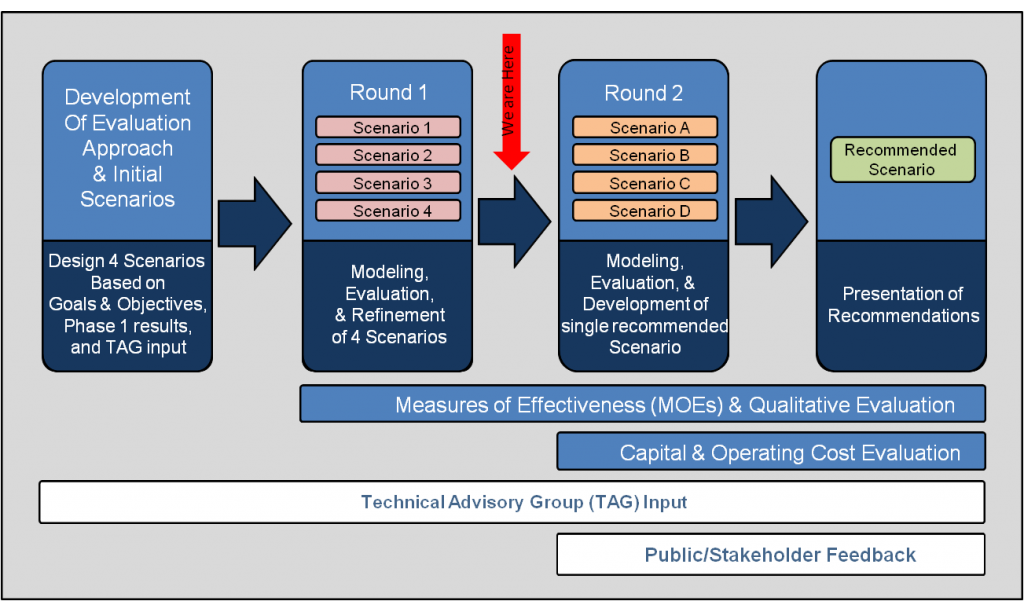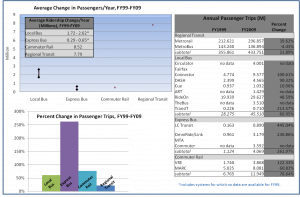In September, we presented to the TAG the results of the first round of scenarios modeled in the second phase of the RTSP study. Scenarios are defined by a collection of strategies or projects identified in the initial phase of the RTSP. The four scenarios tested focused on maximizing the existing infrastructure, expanding surface transit, expanding transit in the core, and expanding transit system wide. The performance of each scenario was evaluated against a set of measures to determine the relative effectiveness of each compared to the baseline scenario, defined by the regional list of projects in the currently adopted Constrained Long Range Plan, and MWCOG Cooperative Forecasts Round 8.0 land use.

Phase II Process Overview: Click to Enlarge
Regional measures such as total transit trips, mode share, vehicle miles traveled, households and jobs within a half-mile of transit, travel time savings, and transit congestion were evaluated to not only determine how well the scenarios performed against each other over the baseline, but to assess how well each satisfied the goals and objectives of the RTSP. In addition to these broad-based regional measures, the first round of scenario modeling focused on how well each scenario addressed the need to expand capacity within the system core. Peak period Metrorail link capacity and transfer activity at key core stations were measured against the baseline scenario to determine if the potential build scenarios could provide sufficient capacity to serve future demand, and how well such added capacity could be utilized.
For more information on scenario descriptions, measured results, and key findings download meeting materials: TAG 9 Presentation of Results
Read more…
Metro is developing the Regional Transit System Plan (RTSP), a vision of a sustainable, integrated, multimodal, regional transit net work for 2040. Metro staff have recently completed the first phase, and presented a summary to the Technical Advisory Group (TAG) in January. Phase II is underway, and the proposed approach and initial scenarios to evaluate were also presented to the TAG.
work for 2040. Metro staff have recently completed the first phase, and presented a summary to the Technical Advisory Group (TAG) in January. Phase II is underway, and the proposed approach and initial scenarios to evaluate were also presented to the TAG.
During the initial phase, Metro staff assessed future growth trends and travel-demand patterns throughout the region for the forecast year 2040. Regional growth, reported by MWCOG Cooperative Forecasts Round 7.2a, shows significant population, household, and employment growth over the next several decades. This growth has a direct impact on travel patterns around the region. As a part of Phase I work, Metro staff identified the implications this has for transit.
Forecasts show that with the implementation of the projects included in the 2009 financially constrained long-range plan (CLRP) regional transit trips will grow by 30% by 2040. Although the regional program of projects in the CLRP results in a transit mode share remaining at only 4% of total person trips, the region will see more than 350,000 new weekday transit trips. Given the anticipated growth and dispersion of travel, the RTSP focuses on the following long-range issues:
- Increasing the capacity of the system to serve the region’s employment core;
- Improving multimodal access to high quality transit;
- Improving the efficiency and interoperability of the region’s surface transit;
- Improving connections to Regional Activity Centers;
Read more…
The Regional Transit System Plan (RTSP) is intended to update the currently adopted Transit System Expansion Plan (TSEP) that was completed in 1999. In its implementation, the RTSP looks beyond the planning horizon of the TSEP by an additional fifteen years and incorporates updated travel demand, population and employment forecasts for the region. The following discussion will look at how much ridership growth has occurred over the ten-year period between 1999 and 2009, and will look at changes in the regional growth projections out to 2040 that will shape future demand for transit services.
Changes in Ridership

Figure 1. Change in ridership. Source: NTD
As envisioned in the adopted plan, transit ridership has grown since 1999, and is on the way toward the TSEP goal of doubling ridership by 2025. Annual transit passenger trips throughout the region have increased by about 30% in the first 10 years of the 25 year planning horizon. However, this growth in ridership has not been consistent across the region: close inspection of these data shows that ridership growth is happening at a faster rate on local feeder bus, express bus, and commuter rail services than for regional Metrorail and Metrobus services, although Metro accounts for the majority of the growth in absolute terms. The growth in ridership on local and commuter transit services highlights the need to create a transit plan that looks beyond the services provided only by Metro and to focus on the region at large.
Read more…

Before Metro and the TAG could begin the discussion of new transit services, it was important that we review and assess the population and employment forecasts for the year 2040. The second TAG Meeting provided us with an opportunity to evaluate transit trips in the region and assess growth patterns and findings to develop an understanding of the impact of these trips on future transit capacity. A key indicator of transit demand is the land use surrounding the transit resource. To learn more about the key employment and activity centers in the region, Metro staff conducted over a dozen meetings with local jurisdictions and federal agencies in the metropolitan region to inform the RTSP development process.
TAG Meeting 02 – March 2010






Recent Comments